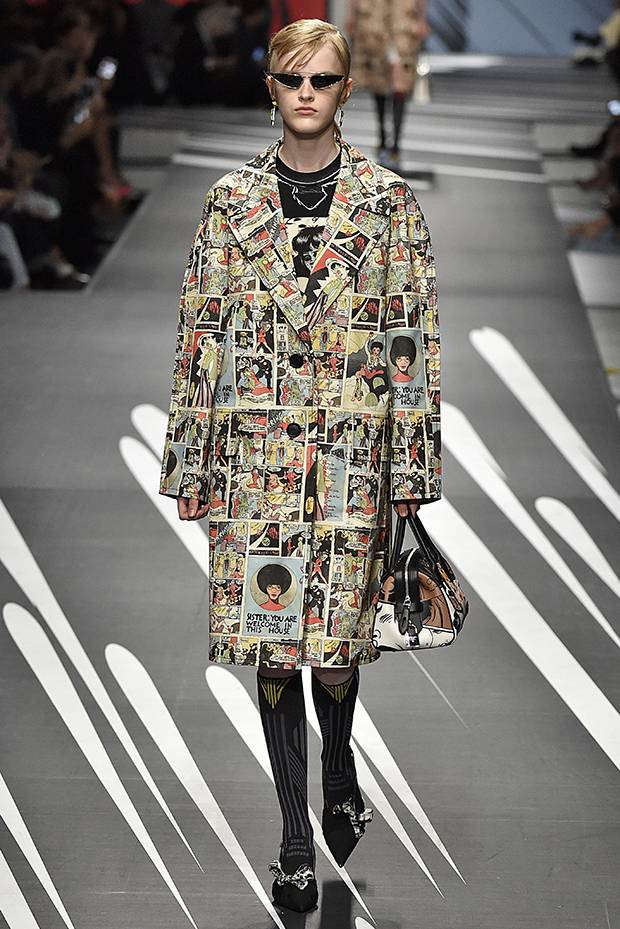In 1971, Linda Nochlin penned a landmark essay for ARTnews titled Why Have There Been No Great Female Artists? The provocative piece was a response to a casual remark by noted gallerist Richard Feigen about having difficulty finding "great women artists."
"It haunted me," Nochlin explained in an interview with critic Maura Reilly. "It made me think, because, first of all, it implied that there were no great women artists. Second, because it assumed this was a natural condition."
The pioneering scholar of feminist art history and criticism died on Oct. 29, but not before Prada's Spring 2018 collection offered a response to her original question (coincidentally, Nochlin's query also showed up on a T-shirt in Christian Dior's collection). Prada's mixed-media garments encrusted with buttons or pyramid studs feature the artwork of eight women cartoonists. Initially, I dismissed it as just another season of opportunistic go-girl branding, but it's much more than that. As a fan of the comics medium, designer Miuccia Prada's choices are eclectic and once remixed and re-contextualized with one another into textiles, offer a fresh take on storytelling and complex female identities.
One key element of the Prada collection, for example, is a sketch of American political activist Angela Davis and the phrase "Sister: You Are Welcome in This House," by underground cartoonist Trina Robbins, now an influential comics historian and advocate for women's contributions to the field. In her new memoir Last Girl Standing, Robbins writes about how she came to draw the 1970 portrait: "The romantic notion was that Angela Davis, on the lam from the law, would be walking past your house, coat collar turned up against the fog; she'd see your poster and knock on your door."
On the phone from her home in San Francisco, Robbins explains that the now iconic art ran on the back cover of the first all-women comic It Ain't Me, Babe. "She was almost, for me, like a comic book heroine – a beautiful African-American woman who was wanted by the FBI," she says.
Through scholarship and editing reprint editions, Robbins has been a vocal champion of overlooked female cartoonists including Tarpé Mills (a.k.a. June Tarpé Mills). Mills is another of Prada's featured female artists and she created Miss Fury, the first costumed female action hero created by a woman. Launched in an April, 1941 weekly adventure comic, Mills produced it using a pseudonym to conceal her gender. The comic features stylish socialite and adventurer Marla Drake and her Nazi-hunting alter ego Miss Fury, who preceded both Wonder Woman and Canada's own superheroine Nelvana of the Northern Lights by several months.
"I've always said that she's like film noir," Robbins explains of Drake/Fury, who has no innate superpowers. "But she can fight for herself even if the only weapon she is using is a telephone or a high-heeled shoe!" Crime fighting in her signature black catsuit, Miss Fury has natural agility and bravery, the latter presumably fuelled by a rage her surname more than suggests.
Prada also features the work of contemporary Canadian artist Fiona Staples, co-creator and illustrator of the epic space opera
Saga, and of Italian cartoonist Giuliana Maldini, who, like Robbins, has been challenging the patriarchy since the 1970s. There's also cartoonist Joelle Jones's Lady Killer Josie, a cheery Betty Draper-type housewife in suburban Florida who finds fulfillment outside the domestic sphere as an assassin for hire. It's a sort of period Breaking Bad black comedy that not coincidentally, takes place on the eve of Betty Friedan's groundbreaking The Feminine Mystique and subverts the cheerful stereotype of midcentury Americana.
The aesthetics of Prada's chosen comics informs the collection's design. The jagged moths and ominous insects of Emma Ríos's mystical western Pretty Deadly feature in intarsia knits. Another runway look of a bustier over a crisp shirt could be taken from a Mills panel and several pieces reflect the swashbuckling Miss Fury's penchant for leopard and tiger print. Japanese manga-ka Natsume Ono or witchy Stellar Leuna's horned goat witch femme fatale inspire the collection's slim futuristic cat-eye shades, and even the models' sleek shags are straight out of Saga and Brigid Elva's witchy HEX zine.
"I want one of everything," says Robbins with a laugh. That wish list includes the handbag emblazoned with another of her drawings, from a 1970s Rosie the Riveter comic strip. In the image, there are speed lines around intrepid Rosie's Victory roll hairstyle as though she's doing a double take.
It's fun to imagine Rosie is reacting to another art-driven fashion collection, Louis Vuitton's "The Masters" collaboration, which features imagery from Jeff Koons "Gazing Ball" series that includes Monet, Manet, Turner, Gauguin and Boucher reproductions on scarves and handbags.
Koons is operating in art's narrow historic patriarchy, whereas Miuccia Prada is offering an intellectual project as much as a commercial one, one of social and political engagement that uses cloth as the canvas. It's the same transgressive and anti-establishment practice that Nochlin argued should call the mainstream of art history – and pop culture history – into question. Not all superheroes wear capes.
Visit tgam.ca/newsletters to sign up for the Globe Style e-newsletter, your weekly digital guide to the players and trends influencing fashion, design and entertaining, plus shopping tips and inspiration for living well. And follow Globe Style on Instagram @globestyle.


